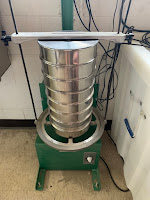Day 7
In the morning, Joe read over Amy's abstract and gave her some feedback. Then, we all went down to Brian's lab on the second floor. He explained his project to us and showed us the eye tracking device that he uses, which tracks the movement of your pupils. The research done in the visual perception lab with this device could be used to track how people behave in the presence of money and where their eyes looked. There are specific symbols on paper money that distinguish real currency from their fake counterparts. This device can track where experts look specifically for the symbols. After Brian showed us around his lab, we all went to our labs. Chris looked over my finalized test plan and made some minor changes. Before lunch, since we had nothing else to do, Hannah and I decided to do a test run of the sieve shaker with a sand sample we found in one of the cupboards. We used the entire container of sediment, which weighed about 997 grams. We turned on the sieve shaker for a little more than 10 minutes and then recorded the weights of the sand remaining on each sieve after the shaking. At the end of the data collection, we put the measurements in a spreadsheet. After lunch, we repeated the same process but for a 200 gram sample of the same type of sand. Later in the afternoon, Chris showed us how to export the measurements of grain size recorded in ImageJ as well as how to use the small microscope in our lab to take pictures of a sediment sample. Below is a picture of the sieve shaker and an image captured by the microscope.


Comments
Post a Comment